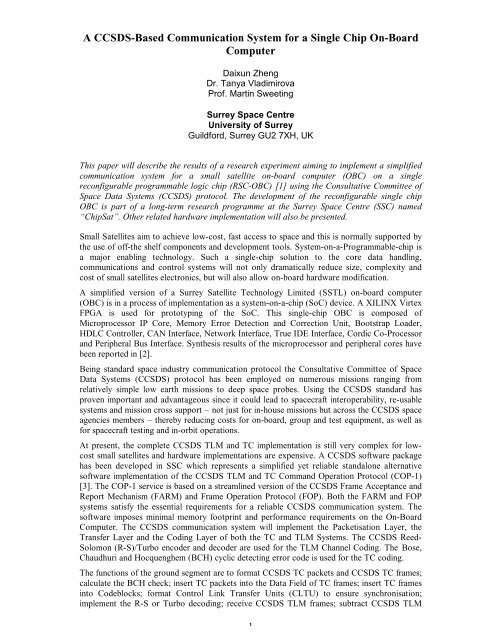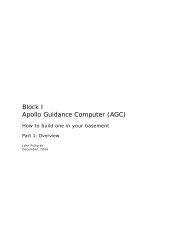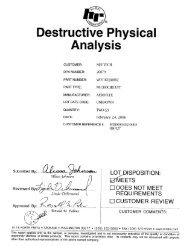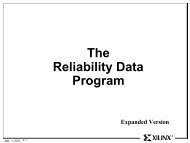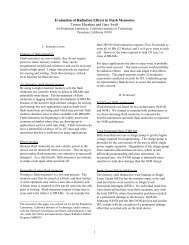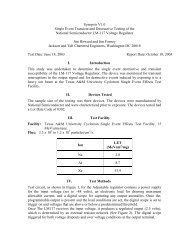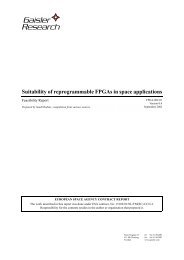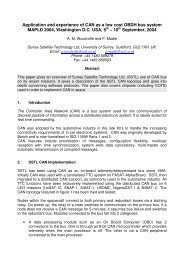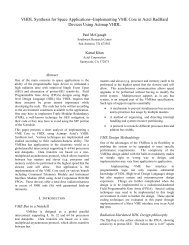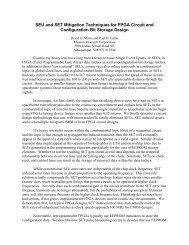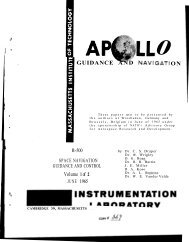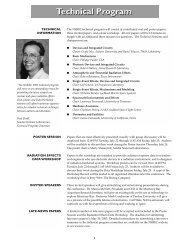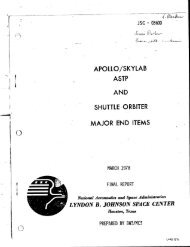A CCSDS-Based Communication System for a Single Chip On ...
A CCSDS-Based Communication System for a Single Chip On ...
A CCSDS-Based Communication System for a Single Chip On ...
Create successful ePaper yourself
Turn your PDF publications into a flip-book with our unique Google optimized e-Paper software.
A <strong>CCSDS</strong>-<strong>Based</strong> <strong>Communication</strong> <strong>System</strong> <strong>for</strong> a <strong>Single</strong> <strong>Chip</strong> <strong>On</strong>-Board<br />
Computer<br />
Daixun Zheng<br />
Dr. Tanya Vladimirova<br />
Prof. Martin Sweeting<br />
Surrey Space Centre<br />
University of Surrey<br />
Guild<strong>for</strong>d, Surrey GU2 7XH, UK<br />
This paper will describe the results of a research experiment aiming to implement a simplified<br />
communication system <strong>for</strong> a small satellite on-board computer (OBC) on a single<br />
reconfigurable programmable logic chip (RSC-OBC) [1] using the Consultative Committee of<br />
Space Data <strong>System</strong>s (<strong>CCSDS</strong>) protocol. The development of the reconfigurable single chip<br />
OBC is part of a long-term research programme at the Surrey Space Centre (SSC) named<br />
“<strong>Chip</strong>Sat”. Other related hardware implementation will also be presented.<br />
Small Satellites aim to achieve low-cost, fast access to space and this is normally supported by<br />
the use of off-the shelf components and development tools. <strong>System</strong>-on-a-Programmable-chip is<br />
a major enabling technology. Such a single-chip solution to the core data handling,<br />
communications and control systems will not only dramatically reduce size, complexity and<br />
cost of small satellites electronics, but will also allow on-board hardware modification.<br />
A simplified version of a Surrey Satellite Technology Limited (SSTL) on-board computer<br />
(OBC) is in a process of implementation as a system-on-a-chip (SoC) device. A XILINX Virtex<br />
FPGA is used <strong>for</strong> prototyping of the SoC. This single-chip OBC is composed of<br />
Microprocessor IP Core, Memory Error Detection and Correction Unit, Bootstrap Loader,<br />
HDLC Controller, CAN Interface, Network Interface, True IDE Interface, Cordic Co-Processor<br />
and Peripheral Bus Interface. Synthesis results of the microprocessor and peripheral cores have<br />
been reported in [2].<br />
Being standard space industry communication protocol the Consultative Committee of Space<br />
Data <strong>System</strong>s (<strong>CCSDS</strong>) protocol has been employed on numerous missions ranging from<br />
relatively simple low earth missions to deep space probes. Using the <strong>CCSDS</strong> standard has<br />
proven important and advantageous since it could lead to spacecraft interoperability, re-usable<br />
systems and mission cross support – not just <strong>for</strong> in-house missions but across the <strong>CCSDS</strong> space<br />
agencies members – thereby reducing costs <strong>for</strong> on-board, group and test equipment, as well as<br />
<strong>for</strong> spacecraft testing and in-orbit operations.<br />
At present, the complete <strong>CCSDS</strong> TLM and TC implementation is still very complex <strong>for</strong> lowcost<br />
small satellites and hardware implementations are expensive. A <strong>CCSDS</strong> software package<br />
has been developed in SSC which represents a simplified yet reliable standalone alternative<br />
software implementation of the <strong>CCSDS</strong> TLM and TC Command Operation Protocol (COP-1)<br />
[3]. The COP-1 service is based on a streamlined version of the <strong>CCSDS</strong> Frame Acceptance and<br />
Report Mechanism (FARM) and Frame Operation Protocol (FOP). Both the FARM and FOP<br />
systems satisfy the essential requirements <strong>for</strong> a reliable <strong>CCSDS</strong> communication system. The<br />
software imposes minimal memory footprint and per<strong>for</strong>mance requirements on the <strong>On</strong>-Board<br />
Computer. The <strong>CCSDS</strong> communication system will implement the Packetisation Layer, the<br />
Transfer Layer and the Coding Layer of both the TC and TLM <strong>System</strong>s. The <strong>CCSDS</strong> Reed-<br />
Solomon (R-S)/Turbo encoder and decoder are used <strong>for</strong> the TLM Channel Coding. The Bose,<br />
Chaudhuri and Hocquenghem (BCH) cyclic detecting error code is used <strong>for</strong> the TC coding.<br />
The functions of the ground segment are to <strong>for</strong>mat <strong>CCSDS</strong> TC packets and <strong>CCSDS</strong> TC frames;<br />
calculate the BCH check; insert TC packets into the Data Field of TC frames; insert TC frames<br />
into Codeblocks; <strong>for</strong>mat Control Link Transfer Units (CLTU) to ensure synchronisation;<br />
implement the R-S or Turbo decoding; receive <strong>CCSDS</strong> TLM frames; subtract <strong>CCSDS</strong> TLM<br />
1
packets from the Data Field of the TLM frames; decode the CRC and if no error is detected, the<br />
raw TLM data is passed to be analysed and displayed. The functions of the spacecraft segment<br />
are to <strong>for</strong>mat <strong>CCSDS</strong> TLM packets; <strong>for</strong>mat <strong>CCSDS</strong> TLM frames; insert TLM packets into the<br />
Data Field of the TLM frames; calculate the <strong>CCSDS</strong> recommended Cyclic Redundancy Check<br />
(CRC) cyclic code of the frame inserted at the end of TLM frames; <strong>for</strong>mat the Attached<br />
Synchronized Marker (ASM); implement R-S or Turbo encoding; receive and decode <strong>CCSDS</strong><br />
TC frames; detect whether a transmission bit error has been identified by the BCH code. If<br />
there is no error, the telecommand will be passed to the on-board Controller Area Network<br />
(CAN) bus and accepted by the corresponding CAN node. The TC retransmission system<br />
utilises the COP-1 "go-back-n" automatic retransmission protocol, which consists of the pair of<br />
synchronized procedures, FOP (in the ground segment) and FARM (in the spacecraft segment).<br />
The FOP transmits TC transfer frames to the FARM. The FARM returns Command Link<br />
Control Words (CLCW) within the TLM transfer frames.<br />
The experimental set-up <strong>for</strong> the simulation of the <strong>CCSDS</strong> communication system consists of a<br />
XILINX Virtex 800 FPGA prototyping board supporting the on-board operation and a personal<br />
computer (PC), supporting the ground operation. The on-board segment will be run by the<br />
RSC-OBC. An on-board CAN bus system will be used to verify the validity of the whole<br />
system. The CAN interface is implemented as a VHDL IP core and is integrated with the<br />
LEON processor IP core. An external CAN card will take responsibilities of an on-board<br />
payload which will generate TLM data and receive TC data. The <strong>CCSDS</strong> TLM encoder and<br />
decoder are provided by the European Space Agency (ESA). The encoder is implemented in<br />
software which will run on the RSC-OBC. The decoder will be implemented as a VHDL core<br />
in a XILINX FPGA. The RSC-OBC will communicate with the PC via an asynchronous RS-<br />
232 serial port.<br />
The paper will be structured in the following way. The <strong>CCSDS</strong> end-to-end link model will be<br />
overviewed and its TLM and TC simulation models will be presented. The <strong>CCSDS</strong> software<br />
structure and interfaces will be illustrated. An approach to the simulation of the <strong>CCSDS</strong><br />
communication will be outlined. Finally, simulation results will be presented and illustrated.<br />
Refrences:<br />
1. D.Zheng, T.Vladimirova, H.Tiggeler, Prof. Martin Sweeting. “Reconfigurable <strong>Single</strong>-<strong>Chip</strong><br />
<strong>On</strong>-Board Computer <strong>for</strong> a Small Satellite”, 52nd International Astronautical Congress,<br />
Toulouse, France, October 1-5, 2001, IAF-01-U3.09.<br />
2. H.Tiggeler, T.Vladimirova, D.Zheng. “A <strong>System</strong>-on-a-<strong>Chip</strong> <strong>for</strong> Small Satellite Data<br />
Processing and Control”, Proceedings of Military and Aerospace Applications of<br />
Programmable Devices and Technologies International Conference (MAPLD’2000), P20,<br />
September 2000, Laurel, Maryland US, NASA.<br />
3. I. Rutter, T.Vladimirova, H.Tiggeler.“A <strong>CCSDS</strong> Software <strong>System</strong> <strong>for</strong> a <strong>Single</strong>-<strong>Chip</strong> <strong>On</strong>-<br />
Board Computer of a Small Satellite”, AIAA Small Satellites Conference, 2001, SSC01-<br />
VI-4.<br />
2


